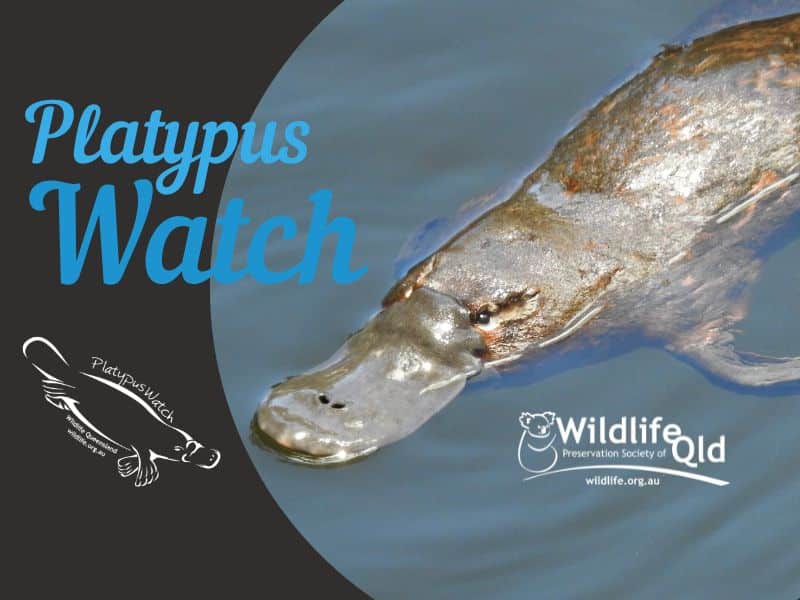
Images (from left to right): Australia’s iconic platypus; Tamielle Brunt and Dr Annabel Smith.
27 July 2023 | Author: Tamielle Brunt
In celebration of Platypus Month this August, Wildlife Queensland’s PlatypusWatch Project Officer, Tamielle Brunt, shares her latest research findings and introduces three new platypus researchers.
Queensland’s platypus conservation and research lag behind Australia’s southern states, where some have over 40 years of ongoing research. Although some long-term observational programs like the 18-year Moggill Creek Catchment Group exist, consistent population research remains sporadic.
The last state-wide census was conducted in 2001, and even after 22 years, Queensland is still advocating for and gathering data about the species throughout the entire state. However, there have been some significant changes in recent years. Starting in 2015, Tamielle’s focus has been researching platypuses (Ornithorhynchus anatinus) within South East Queensland and working towards their conservation across the state.
PhD thesis explores landscapes and gene flow
This year, Tamielle completed her PhD thesis, ‘Platypus populations in a subtropical, urban landscape: Analysing distribution, habitat, and connectivity’. She was fortunate to have Dr Annabel Smith as her PhD Principal Supervisor, whose expertise in landscape genetics and population occupancy modelling perfectly aligned with her research requirements.
With Dr Smith’s guidance, Tamielle developed an occupancy model to understand better the broad habitat features influencing platypus occupancy across Greater Brisbane. Additionally, she conducted landscape genetic analysis to gain insights into the factors affecting platypus gene flow across the landscape.
Introducing three new platypus researchers
Tamielle has started working alongside three students from Dr Smith’s Ecology Lab involved in vital platypus research in Queensland. Details about their research projects are described below.

Image (from left to right): Justine, Jiaqi, and Kat in the field taking eDNA water samples.
Justine Ohlrich is a PhD student researching platypus food resource availability and the effect of fire on species interactions in freshwater ecosystems. Justine will collect aquatic macroinvertebrate samples from burnt and unburnt sites in Queensland National Parks and use DNA metabarcoding to identify the different macroinvertebrate species and how their abundance affects platypus presence. Her favourite thing about the platypus is its rubbery electrosensitive bill, which allows it to find tiny macroinvertebrates underwater with its eyes and ears closed.
Kat McMillan is undertaking her master’s, quantifying key vegetation variables associated with platypus presence and absence in the Greater Brisbane region. Kat has used the eDNA data from the Wildlife Queensland PlatypusWatch eDNA project to study the connection between vegetation and platypus, investigating linkages between platypus and supportive riparian species and unsupportive species. Her favourite thing about the platypus is that they are venomous and lay eggs – the world’s spiciest omelette maker!
Jiaqi Li is a PhD student and is co-supervised by Dr Smith. Her PhD project focuses on understanding changes in platypus distribution across Australia over long geological timescales in response to natural and anthropogenic drivers by identifying climate refugia from the past. Jiaqi’s research also includes investigating and prioritising refugia areas for future platypus conservation. Her favourite thing about the platypus is their extraordinary appearance, charming looks, and venomous spurs on the males.
These projects are important to increase knowledge of platypus habitat, helping to develop more focused management and conservation plans for populations. The researchers will communicate these project outcomes to our communities and stakeholders to create on-ground actions.
“I’m excited about the future of Queensland platypus populations and their conservation nationally!” said Tamielle Brunt.
Happy Platypus Month!
Let’s honour this unique, egg-laying mammal this August and support research initiatives to conserve Queensland’s platypus populations.
Platypus Month is celebrated in August as the end of winter is typically the best time to catch a glimpse of platypus as they forage for food and seek out a mate.
That’s why Wildlife Queensland’s PlatypusWatch is urging all Queenslanders to Report a Platypus Sighting to help build a better understanding of these animals’ status, distribution and conservation needs.
More ways you can support PlatypusWatch and platypus conservation
- For information about Wildlife Queensland’s conservation work with platypus and to learn more about this elusive monotreme, please visit our PlatypusWatch program page.
- Help support our PlatypusWatch work by symbolically adopting a platypus for one year with a tax-deductible donation.
- View PlatypusWatch’s excellent webinar Protecting the Platypus online to learn more about the challenges these incredible animals face.
- Support our campaign to Ban Opera House Nets in Queensland.
- Register to attend our FREE PlatypusWatch Talk at Wacol on 26 August. Details below.
FEATURED EVENT Saturday 26 August, 2:00 pm – 4:00 pm
PlatypusWatch Wolston Centenary Platypus Talk & Results
Pooh Corner Environmental Centre 100 Wolston Road, Wacol, QLD
Wildlife Queensland PlatypusWatch and the Wolston Centenary Catchments invite you to join a talk about platypuses and eDNA survey results. Afternoon tea will be provided.
Free

